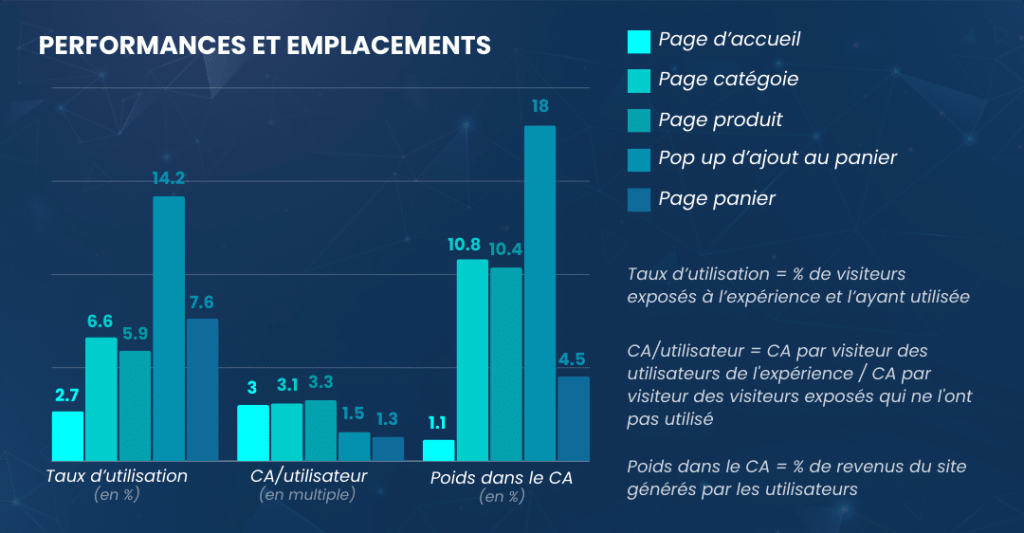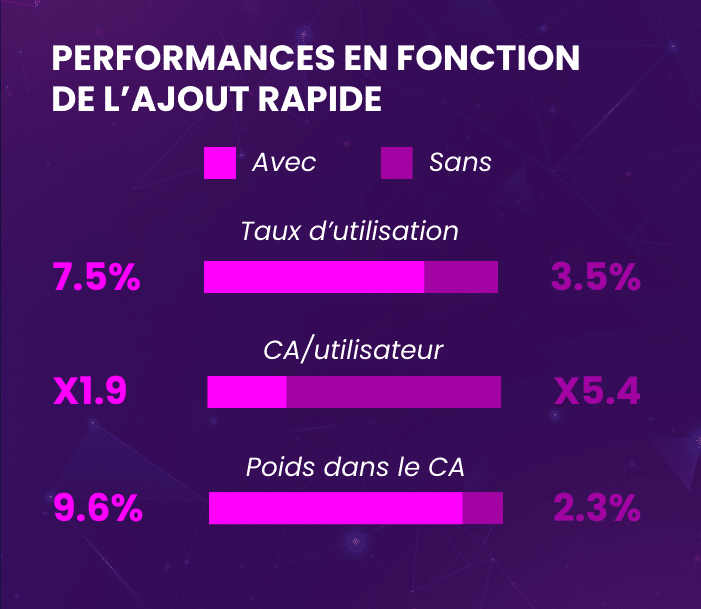🗝️ Key location(s)
From home pages to shopping carts, category pages and product pages, every touchpoint offers an opportunity to present relevant suggestions. But don't underestimate other strategic locations, such as error pages or unsuccessful search results, which can also be used to hold visitors' attention with personalized recommendations.
After an analysis of our customers :
- The location with the highest usage rate (14.2%) is the add-to-cart pop-up,
- Users of recommendation blocks positioned on the product page spend 3.3 times more than other visitors,
- On average, 18% of the site's revenues are generated by users of the recommendation block positioned on the add-to-cart pop-up.
🤔 Static or dynamic?
When it comes to recommendations, the design of various elements needs to be taken into account: the product card, the buttons... However, a significant difference lies in the way recommendations are presented, and therefore the design of the block. Over 73% of blocks are presented as sliders. But what are the advantages of offering a dynamic version of recommended products?
First of all, opting for a slider allows you to display a larger number of products. It's also a way of maintaining the same format, whatever the device. The performance of dynamically presented recommendation blocks differs from that of static blocks, as follows:
- The utilization rate is 3. 8% higher for blocks in slider format than for static blocks,
- Site revenues generated by users are 7.8% higher for blocks in dynamic form.
These results may be explained by the greater possibility of product display, but to be sure, we have analyzed block performance according to product display limit.
👌 Neither too little nor too little
The number of products displayed is also a major parameter to be taken into account to ensure the performance of the recommendation block. First and foremost, we need to differentiate between the notion of simultaneously displayed products and the product display limit. Simultaneously displayed products are the number of products that appear on the screen at the same time; this number may vary according to screen size.
On the other hand, the product display limit is the total number of products displayed in the block. In the case of a static block on desktop, the number of products displayed simultaneously will therefore be similar to the product display limit.
The number of products displayed simultaneously on mobile varies between 1 and 3, which means that the average display is 2 products.
This number varies from 1 to 6 depending on the shape and position of the block, so the average number of products displayed simultaneously is 4.
In the case of a slider, the product display limit is between 3 and 50, with an average of 9 products.
According to our study, the performance of the recommendation block is influenced by the limit of products set. This is explained by the relevance of the products proposed: the higher the limit, the less the products will correspond to the visitor's needs.
Personalized recommendations are one way to improve the user experienceIn addition to the block format, we also need to consider the question of product cards and their functionalities.
🚀 One click to conversion
The appearance of the products presented in the recommendation block is generally identical to that of the product cards on the category page. However, depending on the placement of the block and the desired goal, the product card can be enhanced withfeatures to boost the potential of these products. The presence of a quick add-to-cart CTA can not only capture the visitor's attention on products, but also maximize the chances of them making a spontaneous purchase. Adding this functionality has a direct impact on the user experience, smoothing the purchasing process without forcing the visitor to go to another page. In specific cases, the addition can be completed by size, color or quantity selectors...
Just over half (64%) of the products featured in recommendation blocks have this feature. The performance of blocks whose products have a quick add-to-cart feature differs from the others:
- The utilization rate is 4% higher for format blocks featuring products with quick-add functionality,
- Site revenues generated by users are 7. 3% higher for blocks in format presenting products with the quick add feature.
Mastering recommendations is a major challenge, where every parameter counts. From complex model management to strategic design, recommendations represent a key lever for improving sales performance anduser experience. Since every need, every store and every product is different, the best way to ensure the relevance of the strategy and functionalities deployed is to carry out an AB test.
You can also view detailed performances by location, vertical and discover new comparisons, by download the full infographic from the form below.
Take a look at our article on the best personalization templates, which suggests powerful recommendation strategies.
To download the complete study, please fill in the form below:











